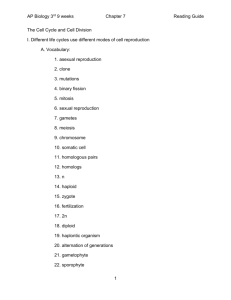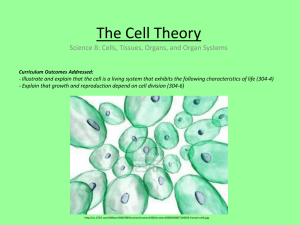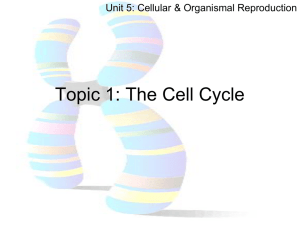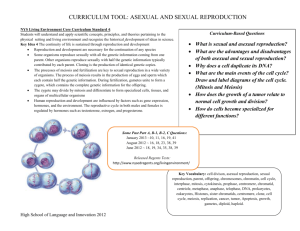Click here for Section 5.4 Study Guide
advertisement
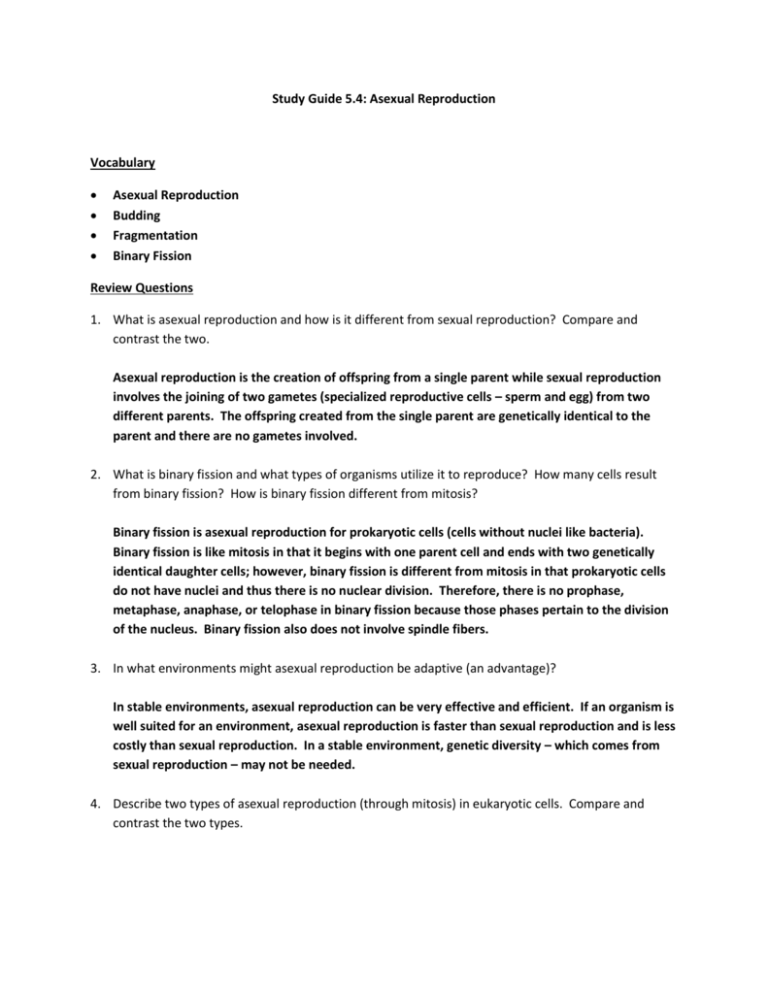
Study Guide 5.4: Asexual Reproduction Vocabulary Asexual Reproduction Budding Fragmentation Binary Fission Review Questions 1. What is asexual reproduction and how is it different from sexual reproduction? Compare and contrast the two. Asexual reproduction is the creation of offspring from a single parent while sexual reproduction involves the joining of two gametes (specialized reproductive cells – sperm and egg) from two different parents. The offspring created from the single parent are genetically identical to the parent and there are no gametes involved. 2. What is binary fission and what types of organisms utilize it to reproduce? How many cells result from binary fission? How is binary fission different from mitosis? Binary fission is asexual reproduction for prokaryotic cells (cells without nuclei like bacteria). Binary fission is like mitosis in that it begins with one parent cell and ends with two genetically identical daughter cells; however, binary fission is different from mitosis in that prokaryotic cells do not have nuclei and thus there is no nuclear division. Therefore, there is no prophase, metaphase, anaphase, or telophase in binary fission because those phases pertain to the division of the nucleus. Binary fission also does not involve spindle fibers. 3. In what environments might asexual reproduction be adaptive (an advantage)? In stable environments, asexual reproduction can be very effective and efficient. If an organism is well suited for an environment, asexual reproduction is faster than sexual reproduction and is less costly than sexual reproduction. In a stable environment, genetic diversity – which comes from sexual reproduction – may not be needed. 4. Describe two types of asexual reproduction (through mitosis) in eukaryotic cells. Compare and contrast the two types. Budding is when a new individual grows, by mitosis, on the surface of the parent – eventually becoming an independent individual (see the hydra below). Fragmentation is when the parent splits into pieces, each of which grows into a new individual through mitosis. 5. How might the asexual reproduction of genetically identical plants be useful to humans? How could it prove harmful to our food supply? By producing crop plants asexually, we are able to take an individual that has the genetic characteristics we like, like taste or size of fruit, and we are able to asexually reproduce it very quickly, in great numbers, and at little cost. The problem is if we encounter a period of environmental instability (like too much or too little water – or insect infestations), the crops will have no genetic diversity (all being from one individual) and may not be able to cope with the changing environment – resulting in major crop losses. 6. How does an organism benefit by being able to reproduce both sexually and asexually? When an organism’s environment is stable, individuals are able to reproduce quickly through asexual reproduction; however, if the environment becomes unstable, individuals can reproduce sexually, which will create genetic diversity – helping the organism to adapt to the changing environment. 7. In ecology, suppose two populations live in the same habitat and compete for food. The first group is larger and uses asexual reproduction; the second reproduces sexually. What could happen to cause the second group to outnumber the first? As long as the environment is stable, the lower costs of asexual reproduction will probably win out. If the environment becomes unstable (for example more floods or fires), the sexually reproducing population will likely have the advantage, due to its genetic diversity, because it is more physically and behaviorally flexible in responding to environmental changes. How does a bud grow? Hydra The bud is an example of asexual reproduction and grows by mitosis. How is mitosis different from binary fission (hint: think of the difference between prokaryotic and eukaryotic cells)? Buds Yeast Mitosis is the division of eukaryotic cells whereas binary fission is the division of prokaryotic cells. Due to the nucleus in eukaryotic cells, there are four phases (prophase, metaphase, anaphase, and telophase), which corresponds to the division of the nucleus. These phases do not exist in binary fission because prokaryotes do not have a nucleus.
